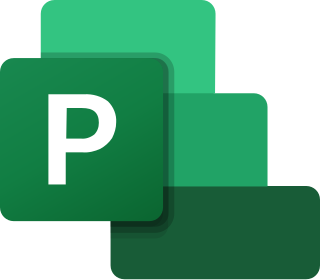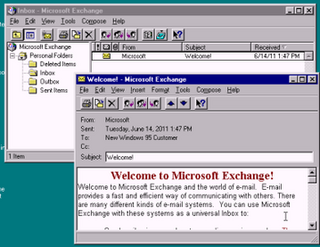Microsoft Windows was announced by Bill Gates on 10 November 1983, 2 years before it was first released. Microsoft introduced Windows as a graphical user interface for MS-DOS, which had been introduced two years earlier. The product line evolved in the 1990s from an operating environment into a fully complete, modern operating system over two lines of development, each with their own separate codebase.

Microsoft Excel is a spreadsheet editor developed by Microsoft for Windows, macOS, Android, iOS and iPadOS. It features calculation or computation capabilities, graphing tools, pivot tables, and a macro programming language called Visual Basic for Applications (VBA). Excel forms part of the Microsoft 365 suite of software.

Microsoft Office, or simply Office, is a family of client software, server software, and services developed by Microsoft. It was first announced by Bill Gates on August 1, 1988, at COMDEX in Las Vegas. Initially a marketing term for an office suite, the first version of Office contained Microsoft Word, Microsoft Excel, and Microsoft PowerPoint. Over the years, Office applications have grown substantially closer with shared features such as a common spell checker, Object Linking and Embedding data integration and Visual Basic for Applications scripting language. Microsoft also positions Office as a development platform for line-of-business software under the Office Business Applications brand.

Windows Update is a Microsoft service for the Windows 9x and Windows NT families of the Microsoft Windows operating system, which automates downloading and installing Microsoft Windows software updates over the Internet. The service delivers software updates for Windows, as well as the various Microsoft antivirus products, including Windows Defender and Microsoft Security Essentials. Since its inception, Microsoft has introduced two extensions of the service: Microsoft Update and Windows Update for Business. The former expands the core service to include other Microsoft products, such as Microsoft Office and Microsoft Expression Studio. The latter is available to business editions of Windows 10 and permits postponing updates or receiving updates only after they have undergone rigorous testing.

The Office Assistant is a discontinued intelligent user interface for Microsoft Office that assisted users by way of an interactive animated character which interfaced with the Office help content. It was included in Microsoft Office for Windows, in Microsoft Publisher and Microsoft Project, Microsoft FrontPage, and Microsoft Office for Mac. The Office Assistant used technology initially from Microsoft Bob and later Microsoft Agent, offering advice based on Bayesian algorithms.

Windows 9x is a generic term referring to a series of Microsoft Windows computer operating systems produced from 1995 to 2000, which were based on the Windows 95 kernel and its underlying foundation of MS-DOS, both of which were updated in subsequent versions. The first version in the 9x series was Windows 95, which was succeeded by Windows 98 and then Windows Me, which was the third and last version of Windows on the 9x line, until the series was superseded by Windows XP.

In computing, a service pack comprises a collection of updates, fixes, or enhancements to a software program delivered in the form of a single installable package. Companies often release a service pack when the number of individual patches to a given program reaches a certain (arbitrary) limit, or the software release has shown to be stabilized with a limited number of remaining issues based on users' feedback and bug reports. In large software applications such as office suites, operating systems, database software, or network management, it is not uncommon to have a service pack issued within the first year or two of a product's release. Installing a service pack is easier and less error-prone than installing many individual patches, even more so when updating multiple computers over a network, where service packs are common.

Microsoft Project is project management software product, developed and sold by Microsoft. It is designed to assist a project manager in developing a schedule, assigning resources to tasks, tracking progress, managing the budget, and analyzing workloads.

Microsoft Office XP is an office suite which was officially revealed in July 2000 by Microsoft for the Windows operating system. Office XP was released to manufacturing on March 5, 2001, and was later made available to retail on May 31, 2001, less than five months prior to the release of Windows XP. It is the successor to Office 2000 and the predecessor of Office 2003. A Mac OS X equivalent, Microsoft Office v. X was released on November 19, 2001.

Microsoft Internet Explorer 5 (IE5) is the fifth, and by now, discontinued, version of the Internet Explorer graphical web browser, the successor to Internet Explorer 4 and one of the main participants of the first browser war. Its distribution methods and Windows integration were involved in the United States v. Microsoft Corp. case. Launched on March 18, 1999, it was the default browser in Windows 98 Second Edition, Windows 2000 and Windows ME and can replace previous versions of Internet Explorer on Windows 3.1x, Windows NT 3.51, Windows 95, Windows NT 4.0 and the original release of Windows 98. Although Internet Explorer 5 ran only on Windows, its siblings Internet Explorer for Mac 5 and Internet Explorer for UNIX 5 supported Mac OS X, Solaris and HP-UX.

Microsoft Office 2000 is a release of Microsoft Office, an office suite developed and distributed by Microsoft for the Windows family of operating systems. Office 2000 was released to manufacturing on March 29, 1999, and was made available to retail on June 7, 1999. It is the successor to Office 97 and the predecessor to Office XP. A Mac OS equivalent, Microsoft Office 2001, was released on October 11, 2000.
Microsoft Plus! is a discontinued commercial operating system enhancement product by Microsoft. The last edition is the Plus! SuperPack, which includes an assortment of screensavers, themes, and games, as well as multimedia applications. The Microsoft Plus! product was first announced on January 31, 1994, under the internal codename "Frosting". The first edition was an enhancement for Windows 95, Windows 95 Plus!

Quick View is a file viewer in Windows 95, Windows 98 and Windows NT 4.0 operating systems. The viewer can be used to view practically any file.

Windows Messaging, initially called Microsoft Exchange Client, is an email client that was included with Windows 95, Windows 98, and Windows NT 4.0.
Development of Windows XP started in 1999 as a successor to the Windows Neptune and Windows Odyssey projects. Neptune was originally going to be the successor of Windows Me, though based on the NT kernel. Microsoft merged the teams working on Neptune with that of Windows Odyssey, Windows 2000's successor, in early 2000. The resulting project, codenamed "Whistler", went on to become Windows XP.
This is a history of the various versions of Microsoft Office, consisting of a bundle of several different applications which changed over time. This table only includes final releases and not pre-release or beta software. It also does not list the history of the constituent standalone applications which were released much earlier starting with Word in 1983, Excel in 1985, and PowerPoint in 1987.

Microsoft Office 95 is a major release of Microsoft Office, released by Microsoft on August 24, 1995, shortly after the completion of Windows 95. It is the successor to both Office 4.2 and 4.3 including their Windows NT versions. While designed specifically for Windows 95, it is compatible with Windows NT 4.0, which debuted in 1996. As it is a 32-bit program suite, it does not run on Windows 3.x or earlier versions of Windows, which use a 16-bit architecture. It is not officially supported on Windows NT 3.1 or Windows NT 3.5. It is officially supported on Windows NT 4.0, Windows Me, and Windows 2000. Support for Windows XP or later versions of Windows was never officially provided.
Microsoft Office shared tools are software components that are included in all Microsoft Office products.

Microsoft Office 2016 is a version of the Microsoft Office productivity suite, succeeding both Office 2013 and Office for Mac 2011 and preceding Office 2019, which in turn was succeeded by Office 2021 for both platforms. It was released on macOS on July 9, 2015, and on Microsoft Windows on September 22, 2015, for Office 365 subscribers. Mainstream support ended on October 13, 2020, and extended support for most editions of Office 2016 will end on October 14, 2025, the same day as Windows 10. The perpetually licensed version on macOS and Windows was released on September 22, 2015. Office 2016 requires Windows 7 SP1, Windows Server 2008 R2 SP1 or OS X Yosemite at the minimum. It is the last version of Microsoft Office to support Windows 7 SP1, Windows Server 2008 R2 SP1, Windows 8, Windows Server 2012, Windows 8.1, Windows Server 2012 R2, Windows 10 RTM–1803 and Windows Server 2016 and Windows 11 until version 23H2; as the following version, Microsoft Office 2019 only supports Windows 10 version 1809, Windows Server 2019 or later.
















